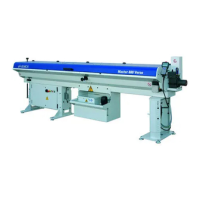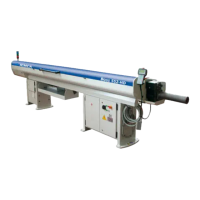Do you have a question about the IEMCA VIP80E-II and is the answer not in the manual?
Details the conditions for product warranty validity and duration.
Explains the manual's objective and how to use its symbols.
Describes the information found on the machine's identification plate.
Provides guidelines for requesting technical assistance and information.
Defines key terms used throughout the manual for better understanding.
Lists all supplementary documents included with the bar feeder.
Introduces the bar feeder and its two manufactured versions (SX and DX).
Details the sequential phases of the bar feeder's automatic operation.
Identifies and describes the function of safety guards and emergency stop buttons.
Explains the meaning and location of safety warning labels on the machine.
Provides a detailed table of technical specifications and dimensions.
Describes optional equipment that enhances bar feeder performance and versatility.
Outlines critical safety rules for operating, using, and servicing the bar feeder.
Specifies safety precautions for moving, installing, and connecting the equipment.
Details safety measures to be followed during machine adjustments and parameter configuration.
Covers essential safety practices for daily operation and interaction with the bar feeder.
Enforces safety protocols required before, during, and after maintenance operations.
Highlights residual risks, particularly pneumatic energy, and precautions for maintenance.
Covers preliminary notes, packaging, transport, lifting, and safety.
Details installation steps, including height adjustment, alignment, and fastening for both types.
Guides electrical connection, pneumatic setup, parameter setting, and final testing.
Advises activating safety devices and informing personnel before any adjustment.
Explains how to adjust the minimum threshold of the pressure switch.
Details mechanical and parameter adjustments for hexagonal and square bars.
Guides the adjustment of the extension's guide height based on bar diameter.
Explains automatic adjustment of the loading axis based on bar size and type.
Emphasizes safety, following instructions, and proper machine usage.
Describes the main switches, buttons, and keyboard functions for machine control.
Details the functions of various keys and modes on the handheld keyboard.
Provides instructions and safety warnings for loading bars into the magazine.
Explains starting automatic cycles, normal stops, and emergency procedures.
Stresses activating safety devices and warning personnel before maintenance.
Provides a table outlining scheduled maintenance tasks and their frequencies.
Details the procedure for checking and potentially replacing the revolving tip.
Illustrates the locations requiring lubrication for proper machine function.
Explains how to use the displacement device for tooling and maintenance access.
Lists common problems, their causes, and solutions for general operation.
Addresses issues related to bar loading and magazine functionality.
Covers problems encountered during the bar feeding process and their resolutions.
Emphasizes using original parts and following safety procedures for replacements.
Provides instructions for the removal and installation of a new revolving tip.
Explains how to replace the battery in the handheld keyboard unit.
Lists recommended spare parts with codes, names, features, and quantities.
Outlines safety and environmental considerations for dismantling the bar feeder.
| Type | Bar Feeder |
|---|---|
| Model | VIP80E-II |
| Manufacturer | IEMCA |
| Max bar diameter (Round) | 80 mm |
| Max bar diameter (Hex) | 70 mm |
| Feeding speed | Up to 60 m/min |
| Remnant Length | 50 mm |
| Bar Length | 3000 mm |
| Control System | PLC |
| Power Supply | 400V 3-phase |
| Dimensions (L x W x H) | 3500 x 1200 x 1800 mm |


